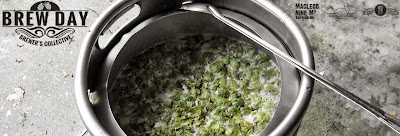While perusing the grown up candy store that is
Bottles and Cans I decided to grab a four pack from
4 Hands Brewing, a brewery I had briefly tasted while visiting some friends in St. Louis. I assure you the four cans from 4 Hands pun was lost on me until this very moment... and I'm tempted to re-title this and write only in puns... but I won't. Sadly.
I had grand plans of visiting the brewery while celebrating America's birthday in the land of whatever-it-is-St.Louis-calls-itself. I was still licking my wounds from the US' exit from the World Cup, so baseball and beer seemed a great cure. Baseball, as always, proved to cheer the spirits (even NL baseball), but the brewery was going to have to wait for another day. Food took precedence over beer with the group and off we went to another locale. However, should you find yourself at a Cardinals game, 4 Hands is a scant 3/4 of a mile from Busch Stadium and will most likely make you feel better about watching a game with poor poor pitchers being forced to go up there and bat.
Anyway, back to the brewery. One of the things I thoroughly enjoyed about the four pack I picked up was the on-can suggested pairings for each brew. From Charcuterie to Camembert Cheese, 4 Hands has left no culinary stone unturned (I'll mention each one in the reviews). As for the descriptions, those are straight from the
4 Hands Beer List. My notes come last. To the beer!
Alter Ego
Suggested Pairings: Charcuterie, Rotisserie Chicken
Description: Alter Ego is a Black IPA brewed with Citra and Zythos hops. Don't let the color fool you, this isn't your traditional dark beer. This American IPA is bright and citrusy with a vibrant hop aroma.
My Take: This was easily the best of the bunch. I'm always a sucker for a black IPA and this was no different. The hops come on quite strong up front as you'd hope in an IPA, but they're balanced out quite nicely with the citrusy middle flavor. The sweet malts and almost grapefruit like citrus flavors really help make this one smoother overall than you'd expect from an IPA. Highly recommend this beer.
Reprise Centennial Red
ABV: 6.0%
Suggested Pairings: Grilled Beef, Sharp Cheddar
Description: The centennial hop is the centerpiece of our American Red Ale. Reprise pushes the limits of a single hop with an amazing bouquet and stunning bitterness all the way through. The citrus character provides an experience you will want to repeat. Reprise is crimson in color with aromas of citrus fruit and biscuit malt.
My Take: Quite the opposite of Alter Ego, this red starts with caramels and breads mixed with a touch of sweetness. Their mentioning of a biscuit malt is spot on, as the middle tastes like a bitter biscuit (in a good way), and it finishes smoothly. And yet... in spite of it doing everything a red should do, it's just... meh. It's not a bad beer, nor disappointing by any stretch of the imagination, it's just quite middling.
Single Speed Session
ABV: 5.0%
Suggested Pairings: Poultry, Camembert Cheese
Description: Our American blonde ale is a soft and delicate ale brewed with pilsner malt and jasmine flower. The addition of jasmine adds a floral and slightly fruity layer. Single speed pours a crisp golden hue with floral undertones. What's your speed? Ours is a Single Speed.
My Take: It's as grassy and floral-y as advertised. It's also quite light and would be easy to take down in rather large quantity while barbecuing, tailgating, or porch sittin. However, much like the Centennial Red it left me quite in the middle. I wouldn't be upset to be handed one of these on a fine summer's day, but I'm also not going out of my way to pick up a full six pack any time soon.
Contact High
ABV: 5.0%
Suggested Pairings: Spicy Food, Poultry
Description: Not just another boring wheat ale. We made Contact High, our spring and summer seasonal, exciting by adding copious amounts of pacific northwest hops and dry hopping with fresh orange zest. Contact High pours a bright orange hue with a big citrus aroma.
My Take: Wheat beers and I just really aren't friends. Don't get me wrong, I'd like to be, but they all have an objective to destroy my stomach. Full on biological warfare the likes of which haven't been seen since the Black Death. Well... that's overstating it. So, with that in mind, I had a few sips and passed it off to my lady. Unfortunately she had the same review of this that I had of most of the 4 Hands beers: not disappointing, but not amazing.
Overall I'd have to say 4 Hands is fine. It's far better than the swill that put St. Louis on the map, but that's not saying much. So, to be nicer, it's a fine brewery. You won't be disappointed with anything they do, but I don't suspect you'll be overly blown away by much either. The Alter Ego is far and away their best and where I'd recommend starting.
But I'm just one man. What're your thoughts? Did I grab a run-of-the-mill four pack? Are their other offerings packing more
moments of wow? I'd love to hear your thoughts in the comments below!
















